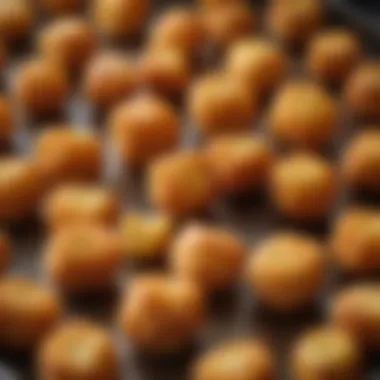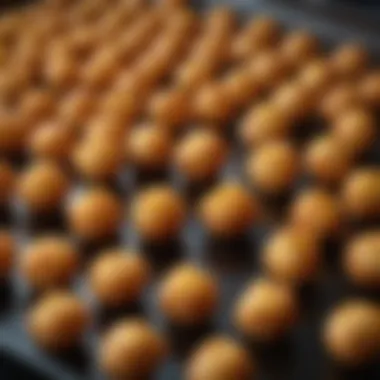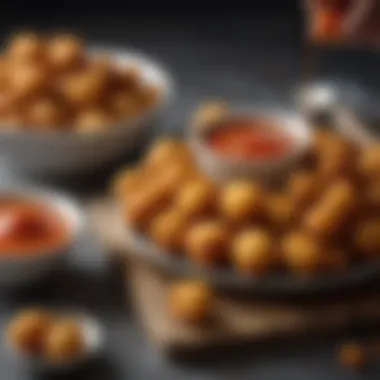Mastering Tater Tots in a Convection Oven: Tips & Tricks


Intro
Tater tots have a way of landing a spot on dinner plates and snack tables alike. There's something about their crispy exterior and soft interior that wins over taste buds. However, if you've ever tried making them in a convection oven, you might have realized that it's not just a simple pop-them-in method. This article dives into every aspect of cooking tater tots in a convection oven, ensuring you get that delightful crunch every time.
The convection oven, known for its even heating and efficiency, is a true game-changer when it comes to preparing tater tots. Unlike traditional frying methods, using a convection oven not only simplifies the process but also reduces the amount of oil needed. This means you can achieve crispy results without the guilt. That’s something every food lover appreciates!
Furthermore, understanding how to harness the unique cooking techniques of a convection oven can elevate your culinary skills. Whether you’re a novice who just wants a quick snack or an experienced cook looking to impress friends, this guide is going to enrich your tater tot game.
Let’s dive in and explore how to master these golden bites.
Prelude to Tater Tots
Tater tots, those delightful little nuggets of crispy satisfaction, hold a special place in the culinary world. They're more than just a side dish; for many, they evoke feelings of nostalgia and comfort. This section dives into the essence of tater tots, shedding light on why knowing about them is crucial in mastering their preparation, especially in a convection oven.
The significance of exploring tater tots lies in understanding their rich background and culinary transformation over the years. As a versatile snack, they can be enjoyed in numerous ways—served alone, alongside dips, or even as part of a larger dish. Knowing their origin aids in appreciating their role in modern cuisine, enhancing cooking experiences for both chefs and home cooks alike.
By understanding the appeal and practical cooking methods surrounding tater tots, readers will gain insight into how to create a dish that is more than just food on a plate; it’s about crafting an experience.
Origin and History of Tater Tots
Tater tots were invented in 1953 by the founders of Ore-Ida, a brand that sought to make use of leftover potatoes. The original idea was to create a product that utilized potato scraps, leading to the invention of these tiny, fried potato bites. Their introduction into American kitchens was a game changer, as they quickly became a staple in school cafeterias and family dinners across the country. These modest beginnings demonstrate how a simple idea can evolve into a beloved dish enjoyed by generations.
Tater tots gained momentum in the 1980s, coinciding with the rise of frozen convenience food. Their ready-to-cook nature made them a hit among busy families. Since then, they have transformed from a mere side dish into a canvas for culinary creativity, inspiring inventive recipes that go beyond simple salt and pepper seasoning. Today, tater tots can be found at top-notch restaurants and food trucks, often embellished with gourmet toppings and sauces, proving that they have transcended their humble roots.
Culinary Appeal of Tater Tots
The culinary allure of tater tots is undeniable. Their crispy exterior coupled with a soft, fluffy interior creates a textural contrast that is simply irresistible. This duality appeals to food lovers of all ages, making them a universally liked snack or side dish. The versatility in preparation is another feather in their cap; they can be baked, fried, or, as this article focuses on, cooked in a convection oven, allowing for crispy results without an overload of oil.
Additionally, tater tots are like a blank canvas, inviting a variety of flavor enhancements through dips, spices, and accompaniments. Whether you prefer classic ketchup, a spicy aioli, or even loaded with cheese, bacon, and sour cream, their adaptability makes them a favorite for gatherings, parties, or a cozy night in.
"Tater tots turn any meal into a celebration, merging simplicity with creativity."
Understanding the origin and appeal of tater tots provides the foundation needed before diving into the technical side of cooking them, especially in a convection oven. It’s essential to recognize this beloved dish’s evolution and versatility to appreciate the precise techniques behind achieving the perfect tater tot.
Understanding Convection Ovens
In the culinary world, the way heat is distributed plays a significant role in the cooking process. In this section, we'll explore convection ovens—an appliance that has changed the game for many home cooks and chefs alike. This understanding is crucial to mastering the art of cooking tater tots, as it will influence the texture and flavor of your finished product. Knowing the ins and outs of convection cooking equips you with the skills to achieve crispy tots that are golden brown, unlike those soggy batches we all dread.
What is a Convection Oven?
At its core, a convection oven is an oven that uses a fan to circulate hot air around the food. This makes it different from traditional ovens, which mainly heat from the bottom or top. The constant movement of hot air helps to ensure that food cooks evenly and often more quickly. Think of it as a gentle breeze that helps your tater tots bake more uniformly.
The fan and exhaust system in convection ovens help maintain a consistent temperature by removing excess moisture from the air within the oven. As a result, not only do you get even cooking, but you often end up with a better texture—especially important for achieving that coveted crunch on your tater tots.
How Convection Cooking Works
Convection cooking operates on a simple principle: hot air rises. When the oven is preheated, the heat generates from the heating elements, then the fan kicks in, distributing this warmth evenly throughout the cooking space. One can liken it to a gentle whirlpool—just like water spins smoothly in a current, the hot air wraps around each tater tot, wrapping them in an even coat of heat.
Furthermore, the process leads to a faster cooking time. With the fan doing much of the work, food is often done in less time compared to regular ovens—up to 25% faster, in fact. This quick and efficient approach is particularly beneficial for items like tater tots, where crispy textures are paramount.
Benefits of Cooking with a Convection Oven
Using a convection oven brings multiple perks:
- Even Cooking: Because the hot air circulates, you don’t have to worry about hotspots that could leave you with undercooked or burned bits.
- Crispier Results: The dry, circulating air helps to evaporate moisture, which is essential for achieving that sought-after crispiness in tater tots.
- Energy Efficiency: As they cook faster, convection ovens may help save on energy consumption.
- Versatility: You can use them for baking, roasting, or even dehydrating food, making them handy for various culinary endeavors.
"Cooking with a convection oven is like having a sous chef; it maximizes your efficiency and ensures consistent results."


Understanding how these ovens function can markedly improve your culinary outcomes. Whether you are making tater tots from scratch or using frozen options, grasping the mechanics of convection cooking will prepare you for achieving gourmet-level flavors with relatively little effort.
Preparing Tater Tots for Cooking
Before diving into the rhythm of cooking tater tots, it is essential to understand why the preparatory steps are the bedrock of a successful outcome. Cooking isn't just about slapping some food in an oven; it's an intricate dance that requires finesse, timing, and a touch of know-how. In the case of tater tots, proper preparation can mean the difference between a crunchy delight and an overcooked, mushy disappointment. Let's unravel why this phase is so crucial, focusing on three key components.
Choosing the Right Tater Tots
Not all tater tots are created equal. The first step in this journey is selecting the right brand or type that will suit your culinary ambitions. Some brands focus on a fluffier interior, while others might tout a heartier crunch. Look for brands that promise quality, like Ore-Ida or Alexia, as they often deliver consistent results. Review the ingredient list; you might be surprised to find some brands use unnecessary additives. Moreover, experiment with different types: sweet potato tater tots can offer a delightful twist.
- Consider factors such as:
- Texture: Aim for those that promise crispy exteriors.
- Ingredients: Stay away from overly processed varieties.
- Flavorings: Some come pre-seasoned, which might complement your meal.
The Importance of Thawing
Many might be guilty of tossing frozen tater tots straight from the package into the oven, thinking it saves time. However, giving them a moment to thaw matters. When frozen tots hit the hot air in a convection oven, that icy exterior can impede even cooking. By allowing them to sit at room temp for a bit, moisture can escape, leading to a better texture at the end of the day. Ideally, aim for about 15 to 20 minutes.
"Thawing is not just a step; it’s a game changer that can transform a soggy experience into crispy perfection."
Prepping Your Ingredients
Preparation goes beyond just thawing. It involves gearing up for the main event of cooking. Arranging your workspace efficiently can streamline the process, allowing for a smooth flow from raw ingredients to plated masterpieces.
Here are the steps you should focus on:
- Gather your tools: Ensure your convection oven is clean and available, along with baking sheets, parchment paper, or cooking spray.
- Seasoning matters: Have your favorite spices or seasonings ready. Garlic powder, paprika, or even just salt can elevate tater tots from ordinary to extraordinary.
- Storage considerations: If you're preparing for a larger group, consider how you will keep cooked tater tots warm while you finish the batch. Warming ovens or covered dishes can maintain that sought-after crunch.
By focusing on these preparatory steps, you're setting the stage for a stellar tater tot experience. Preparing properly means you can waltz right into the cooking phase with confidence, knowing you’ve set yourself up for success.
Cooking Tater Tots in a Convection Oven
Understanding how to cook tater tots in a convection oven is essential for achieving crispy, golden perfection. The unique swirling fan and exhaust system of these ovens circulates hot air, ensuring that every morsel is evenly cooked and maintains a satisfying crunch. The importance here is not simply in the taste, but also in texture; convection ovens can make tater tots less soggy than traditional frying methods. This section guides you through the specifics that lead to a successful batch of tater tots.
Optimal Temperature and Time Settings
Getting the temperature and time right can be the difference between delightful and dismal tater tots. A typical range for cooking tater tots in a convection oven is between 400°F to 425°F. This hotter temperature frys them from all sides, creating that much-wanted crispiness. As every oven behaves slightly differently, it's best to start with about 20-25 minutes. Check your tater tots halfway through and give them a shake to ensure they cook evenly.
There’s always room for adjustment, so if your particular oven is more temperamental, err on the side of caution. Keeping an eye on them as they cook helps avoid potential disasters on a plate.
Arranging Tater Tots for Even Cooking
Arranging your tater tots properly can play a pivotal role in their outcome. It’s tempting to just dump them onto the tray and call it a day, but there’s a bit more to it. Start by spreading the tater tots in a single layer across the baking sheet. If they’re bunched together, they’ll steam instead of become beautifully crispy. Keeping a little space between them allows that hot air to circulate freely, giving each one its fair share of heat.
You might even think about rotating the tray halfway through if your oven has hot spots. It’s a simple trick but one that can elevate your side to restaurant quality.
Using Cooking Spray and Seasonings
While some folks rely on oil to get that crispy edge, cooking spray works wonders too. A light mist of cooking spray on your tater tots before cooking helps them brown evenly without the excess fat. It’s crucial to remember that too much oil can lead to grease-laden, soggy bites.
As far as flavor goes, consider seasoning them before cooking. A sprinkle of salt and pepper is a standard route, but don’t shy away from adding spices for a kick. Think garlic powder, paprika, or even some Parmesan cheese for an indulgent twist. You'll be surprised at how such simple additions can change the game.
Monitoring the Cooking Process
Keeping an eye on your tater tots while they cook means avoiding mishaps like burning or sogginess. The first time you use your convection oven, take notes on how long it takes to reach that crispy state. Check them around the 15-minute mark; they should be turning golden brown.
Also, don’t hesitate to taste one. After all, a cook has to keep their quality control in check!


"The kitchen is a laboratory for flavor; watch and learn, or you might end up with a flop instead of a culinary triumph."
If you notice uneven browning, simply shake the tray to shift them around, and you should be good to go. Ultimately, the goal is to get them just right, allowing you to serve up some irresistible tater tots that’ll leave everyone reaching back for more.
Troubleshooting Common Issues
Cooking tater tots in a convection oven may seem like a piece of cake, but sometimes things don’t go as planned. Troubleshooting common issues is essential because it helps cook enthusiasts achieve the perfect crunch and flavor from their tater tots. Without addressing these problems, you could end up with a soggy mess or unevenly cooked snacks. In this section, we will explore the key challenges you might face and offer practical solutions to ensure your tater tots turn out golden and crispy every time.
Sogginess: Causes and Solutions
Sogginess is the bane of any tater tot lover's existence. It often stems from one or more factors during the cooking process. Here are some common causes:
- Moisture Retention: If your tater tots are frozen and you add them directly from the freezer to the convection oven, the ice crystals can melt and create steam, leading to sogginess.
- Overcrowding: Layering tater tots too close together prevents proper air circulation, making it hard for them to crisp up.
- Low Temperature: Using a temperature that’s too low doesn’t allow the outer layer to develop a crisp texture.
Solutions include:
- Always thaw your tater tots for a few minutes before cooking to minimize ice inside.
- Ensure they’re spread out on the tray with some space in between for optimal air flow.
- Use a higher cooking temperature, ideally around 400°F (204°C), to achieve that golden finish.
"The key to crispy tater tots is letting steam escape, so don’t crowd them!"
Undercooked Tater Tots: How to Fix
Undercooked tater tots are often the result of insufficient cooking time or temperature. If you find yourself biting into a soggy, soft center, follow these remedies to save dinner:
- Increase Cooking Time: If it’s clear they’re underdone, just give them an extra five to ten minutes in the oven. Check frequently to ensure they don’t get burnt.
- Adjust Temperature: If you're cooking on a setting below 375°F (190°C), consider cranking it up to get the heat where it needs to be.
- Use a cooking thermometer to make sure your convection oven is performing accurately—sometimes, what you see isn’t what you get in terms of temperature.
Overcooked Tater Tots: Recognizing Signs
While aiming for crispy perfection, there’s always the risk of going too far. Overcooked tater tots can turn dark or even burnt. To recognize the signs:
- Color: Tater tots should be golden brown; if they shift to dark brown or black, you're heading for a disaster.
- Texture: They should feel firm but slightly yielding to the bite. If they crumble, that means they are overly dry.
- Aroma: A burnt smell can signal that they are done more than needed. Be attentive, as smells can drift away without notice.
To prevent this, pay close attention to time, and perhaps set a timer to check them every few minutes once they are nearing the predicted cooking duration. Adjusting the oven’s temperature and practicing good timing is crucial to ensure they are perfectly cooked to the very last bite.
Serving Suggestions
When it comes to serving tater tots, creativity is your best friend. The way you dish them out can enhance not only the taste but also the visual appeal of your meal. Tater tots are versatile; they can stand alone or complement a variety of dishes. This section aims to illuminate the significance of pairing your tater tots with the right dips, incorporating them into meals effectively, and utilizing garnishing techniques that elevate their presentation.
Pairing with Dips and Sauces
Finding the right dip or sauce to accompany your tater tots is crucial. A good dip can transform an ordinary side into a delightful appetizer. Classic choices such as ketchup or mustard are easy, but why not venture off the beaten path? Try a spicy sriracha mayo for a bit of zing, or a rich cheese sauce that drizzles like a dream. Garlic aioli could bring a gourmet touch, while ranch dressing is a favorite that never goes out of style.
Consider this list of delightful pairings:
- Classic ketchup: The tried-and-true companion.
- Spicy sriracha mayo: Adds a kick, perfect for heat lovers.
- Rich cheese sauce: A comforting option.
- Garlic aioli: For a touch of class.
- Ranch dressing: A crowd-pleaser that complements just about everything.
Dips can be made at home with simple ingredients and can surprise your guests with unique flavors. Don’t hesitate to experiment! An unexpected combination may just become a new favorite around the dinner table.
Incorporating Tater Tots into Meals
Tater tots aren’t just a side dish; they can be seamlessly integrated into main courses as well. For example, consider using them in a breakfast casserole. Layer tater tots with eggs, cheese, and veggies and bake until everything is warm and the tater tots are crispy.
Another idea would be to create a hearty "Totchos" dish, where you pile on ingredients typically reserved for nachos, like cheddar cheese, jalapeños, and green onions. This can be a fun, creative way to serve them at parties or casual get-togethers.
Here are some meal ideas that incorporate tater tots:
- Breakfast casseroles: Perfect for brunch.
- Totchos: A playful twist on nachos.
- Tater Tot stir-fry: Mix with veggies and protein for a filling dish.


The beauty lies in the versatility of tater tots. They’re not confined to just being a freestanding side; let your imagination run wild.
Garnishing Techniques for Presentation
Presentation is key in any meal. A well-garnished dish raises the dining experience to a whole new level. You can elevate simple tater tots by adding a sprinkle of fresh herbs, such as chives or parsley, for a pop of color and flavor.
Drizzling some balsamic reduction can also offer a visual contrast while giving a hint of sweetness that pairs surprisingly well with the savory crispness of tater tots.
Some techniques to enhance presentation include:
- Using colorful herbs: Brighten your plate with fresh garnishes.
- Balsamic drizzle: A sophisticated touch that adds flavor.
- Plating artfully: Arrange them neatly or stack them for a modern look.
Remember, we eat first with our eyes, and a well-plated dish can really kick things up a notch in any setting.
"Food is not just about taste; it's also about how it looks and feels. Presentation is part of the experience."
In summary, serving tater tots is an art. Pair them wisely with dips, integrate them into meals creatively, and present them in an appealing manner. These elements combine to make your tater tots not just a side but a highlight of your dining experience.
Nutritional Aspects of Tater Tots
Understanding the nutritional profile of tater tots is crucial, especially for those who are health-conscious yet still enjoy the comfort of this beloved snack. While tasty, it's important to recognize what makes up these crispy delights and how they might fit into a balanced diet.
Understanding Tater Tot Ingredients
Tater tots are primarily made of grated or shredded potatoes, which are often processed and mixed with some sort of starch, usually to maintain their form. The basic ingredients can include:
- Potatoes: These provide carbohydrates, a primary energy source. They also contain vitamins, particularly vitamin C, and minerals.
- Vegetable oil: This is usually used for frying, adding additional calories and fats. Different oils can vary in health benefits.
- Salt: Enhances flavor but can contribute to sodium intake, so it should be used sparingly.
- Preservatives: Some commercial brands might add preservatives to extend shelf life. Knowing what's in your food can help make better choices.
It's important to read labels and select brands with fewer additives. Home-made options allow for better control over ingredients, thus enhancing the nutritional integrity of the tots.
Healthier Cooking Options and Alternatives
While traditional tater tots are delicious, there are ways to make them healthier without sacrificing taste. Consider the following alternatives and cooking techniques:
- Baking instead of frying: Using a convection oven promotes even cooking and reduces the need for excessive oil compared to traditional frying methods, making the final product less greasy.
- Sweet potato tots: Swap regular potatoes for sweet ones. They have more fiber and are known for their vitamin A content.
- Whole grain breadcrumbs: If you're looking to coat your tater tots before baking, consider whole grain breadcrumbs instead of white flour or traditional breadcrumbs for added fiber.
- Seasoning with spices: Spice things up with herbs and spices instead of salt for added flavor without the extra sodium.
- Adding veggies: Incorporating finely grated carrots or zucchini within the potato mix boosts the nutritional content while adding flavor and moisture.
"Crispiness and health can go hand in hand; a little creativity makes all the difference."
In summary, knowing the ingredients and being conscious of cooking methods can greatly influence the nutritional value of tater tots. By making simple substitutions and utilizing healthier techniques, anyone can enjoy this classic dish without a side of guilt.
Culmination
In summary, mastering the art of making tater tots in a convection oven can greatly enhance your culinary repertoire. Throughout this article, we've explored the nuances that make this cooking method stand out. The convection oven circulates hot air, providing an even cooking environment. This is essential for achieving that ideal crispy exterior while keeping the inside fluffy. It’s not just about crunch; it's also about flavor and texture that defining a perfect tater tot experience.
The key takeaways include the importance of selecting the right brand of tater tots, the necessity of thawing prior to cooking, and the impact of arranging them properly on the baking tray. Plus, we’ve discussed some handy tips for ensuring they are seasoned well while engaging your senses in the process.
Also addressed were common pitfalls that can arise while cooking—nobody wants a soggy or burnt batch. With our troubleshooting tips, you’ll be prepared to face these issues head-on. Ultimately, a good understanding of the convection cooking principles is your ticket to not just making decent tater tots but mastering them.
"Cooking is like love. It should be entered into with abandon or not at all."
Listening to that wisdom, you can explore various ways to serve your tater tots, ensuring they shine at family gatherings, game nights, or just for a casual evening snack. The versatility of this dish cannot be overstated; from simple dips to elaborate meals, the options are truly limitless.
Recap of Key Points
- Convection Oven Features: The circulation of air leads to even cooking, essential for achieving the crunch that tater tots should have.
- Ingredient Selection: Choose quality tater tots; not all brands are created equal, which affects both texture and flavor.
- Preparation Matters: Thaw and arrange tater tots properly before cooking for the best results.
- Troubleshooting Tips: Know how to fix common issues, like sogginess or overcooking, to ensure every batch is a success.
- Serving Suggestions: Tater tots aren’t merely a side—their adaptability makes them suitable for main courses or snacks.
Encouragement for Experimentation
Don’t hesitate to break the mold with your tater tot journey! While traditional recipes lay a solid foundation, mixing things up can lead to unique creations. Try adding different spices before you toss them in the oven, or experiment with various sauces and dips. Perhaps you might be daring enough to make a tater tot casserole with layers of cheese and BBQ?
Another idea is to incorporate fresh herbs or finely chopped vegetables into your mix. This not only boosts the nutrition but adds a flavor profile that can surprise even the most avid tater tot enthusiasts. Remember, cooking should be about creativity and personal touch.
By taking ownership of your recipe and not setting strict boundaries, you may just stumble upon a delightful new favorite that celebrates the humble yet beloved tater tot. So roll up your sleeves, embrace the creative process, and happy cooking!















